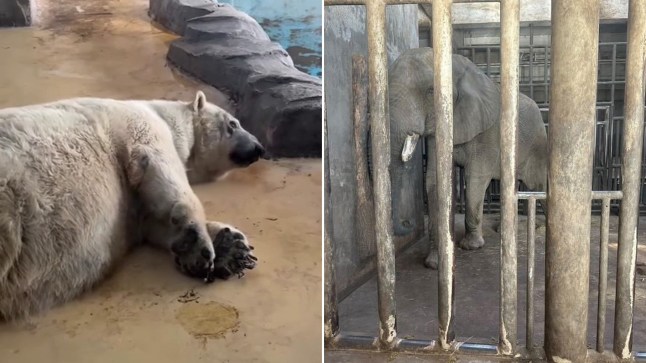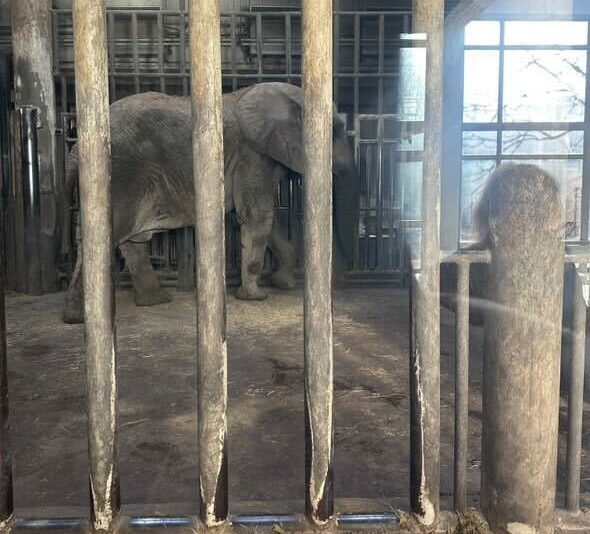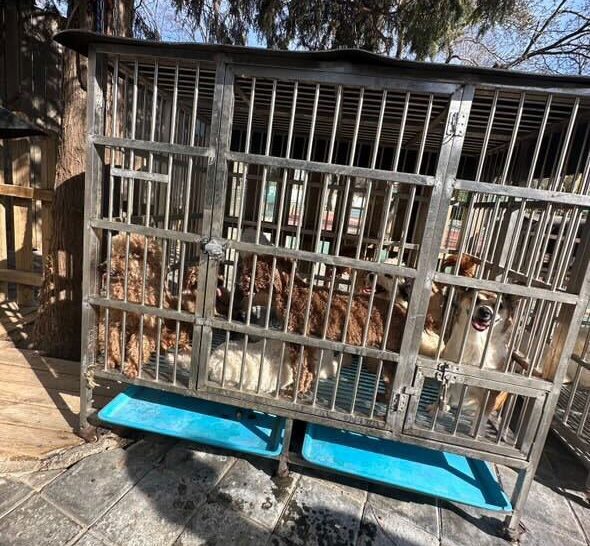
African elephants confined to ‘tiny prison cells’ without access to water. Polar bears locked indoors with nothing but a ‘dirty’ pool. Dogs stuffed into cramped cages.
These are some of the distressing scenes confronting tourists at Beijing Zoo, where concerns are mounting over the treatment and welfare of the animals.
Edina Delic, from Dublin, spoke with Metro about the conditions in China’s oldest public zoo in the Xicheng District, that left her in floods of tears.
The 29-year-old was on holiday in the Chinese capital when she visited the park — an area of 80 hectares, also known as a centre for zoological research that breeds rare animals from across the world.
But what Edina witnessed there left her ‘distraught’. She still chokes up as she recalls the suffering of the animals.
An enclosure with monkeys near the entrance was the first to catch her attention. ‘The number of monkeys was crazy and they didn’t look in the best condition, judging by their coats,’ she said.
‘We were then totally taken back when we moved onto the polar bear. It was in an empty enclosure indoors with nothing but a dirty pool. The bear was sleeping and looked very unwell.’
Edina then witnessed African elephants ‘segregated into individual cages’, which she estimated allowed them to take just two steps in each direction.
Asian elephants – which are significantly smaller than African ones – were also in the same conditions.
‘That broke me. These beautiful giants are pacing these tiny jail cells with not even water in the enclosure,’ she said.
‘One of the smaller elephants was smashing a wooden ball against the metal bars in clear distress, looking for attention. I burst into tears and had to leave… I walked out of the building.’
Distressed, Edina approached a zoo keeper and asked if the elephants ever leave their cages. She was informed that the outdoor enclosure is currently under renovation.
In the children’s section of the zoo, Edina said she saw a row of about 15 cages and large kennels, each stuffed with a variety of dog breeds: Dalmatian, Shiba, Australian Shepard, Cockapoos, Huskies and Corgis.
Some had their fur dyed, and Edina said many had mange and visibile eye infections.

She added that children could select one of the puppies to play with.
Edina described their health as ‘gut-wrenching’, adding: ‘I couldn’t even bear to take a picture of these beautiful little babies.
‘They tried to bark but their vocal cords had been clipped, so it wasn’t even close to a bark. You can imagine how much they would have been barking in these conditions.
‘I left with such a heavy heart. I am crying again recalling it all.’
Metro shared footage of the animals’ disturbing behaviour captured by Edina with Dr Audrey Delsink, from Humane World for Animals Africa.
She told us that elephants, for example, are highly social animals who require extensive home ranges to meet their needs. On average, they walk up to 30 miles per day.
Dr Delsink said that when confined in small spaces, these animals suffer ‘extensive’ clinical, physiological, behavioural and neural problems because of a lack of exercise and mental stimulation, amounting to a trauma response.
She said this often manifests itself as repetitive behaviours such as head-swaying, bobbing, resting and banging against a wall, and has been suggested to even be a coping-mechanism for stress.
Dr Delsink explained: ‘It can lead to poor physical health and ailments and reduced life expectancy. These behaviours can be seen in elephants often within a few weeks to months of being in captivity.’

It is estimated that up to 85% of elephants kept in zoos and 100% of those kept in circuses engage in such behaviour.
Dr Peter Li, a policy expert, said it is ‘not unheard of’ for some zoos in China to dye the fur of dogs to look like other animals.
‘This doesn’t align with the ethical treatment of dogs or any animal but alas many zoos across China have woefully inadequate standards in terms of animal welfare and wellbeing,’ he told Metro.
There have been recent examples of Chow Chows being dyed black and white to look like pandas, and orange and black to look like tigers.
Dr Li explained that zoos in China do not operate under internationally-recognised standards.
While some Western practices have been implemented, the conditions in a typical zoo in China fall short, he said.
Dr Li added: ‘Chinese zoos are a huge business empire where animals are commodities for profit.
‘Many zoos are rogue facilities with no educational or welfare element at all, and some even subject animals to cruel and demeaning circus-like acts.
‘Instead of being truly educational facilities, they do the opposite because the animals can be so depressed and inactive in their barren and small environments, that the paying public see nothing of the true nature of wild animals as they would behave in the wild where they belong.’
Metro contacted the China Zoo Association (CZA) for comment but has received no response.
Get in touch with our news team by emailing us at webnews@metro.co.uk.
For more stories like this, check our news page.
MORE: Grand National horse Celebre D’Allen dies after collapsing during race
MORE: 2025’s ‘obscure’ highest-grossing film has almost broken Titanic’s gigantic record
MORE: Britain hails ‘breakthrough’ in hypersonic weapons test to ‘stay ahead’ of enemies












